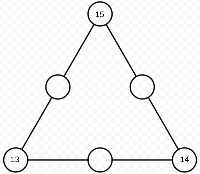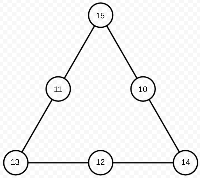Difference between revisions of "1985 AJHSME Problem 24"
(→Solution) |
(→Solution 2) |
||
| (8 intermediate revisions by 4 users not shown) | |||
| Line 19: | Line 19: | ||
<math>\text{(A)}\ 36 \qquad \text{(B)}\ 37 \qquad \text{(C)}\ 38 \qquad \text{(D)}\ 39 \qquad \text{(E)}\ 40</math> | <math>\text{(A)}\ 36 \qquad \text{(B)}\ 37 \qquad \text{(C)}\ 38 \qquad \text{(D)}\ 39 \qquad \text{(E)}\ 40</math> | ||
| − | == Solution == | + | == Solution 1 == |
| − | + | ||
| − | <math></math>S | + | A numeral can appear in a maximum of 2 sides in this triangle, so we can put the largest 3 numbers, 15, 14, and 13 at the corners, as shown in Figure 1. |
| + | |||
| + | [[File:24 fig1.png]] | ||
| + | Figure 1 | ||
| + | |||
| + | Then, we can label the left empty circle as <math>a</math> and the right empty circle as <math>a-1,</math> because 14 is one more than 13, and we need to balance it out for the sum to be the same. The bottom empty circle can be named as <math>a+1</math> because <math>13+14=15+13-1.</math> We only can use the numbers <math>10, 11,</math> and <math>12</math> now, so <math>a=11,</math> <math>a+1=12,</math> and <math>a-1=10.</math> Therefore, the largest value for <math>S</math> is <math>15+11+13=10\cdot3+(5+3+1)=\boxed{39~\textbf{(D)}}.</math> | ||
| + | |||
| + | But, we have to make sure that all three sides sum to 39. The completed triangle is shown in Figure 2. | ||
| + | |||
| + | [[File:24 fig2.png]] | ||
| + | Figure 2 | ||
Latest revision as of 08:58, 10 June 2024
Problem
In a magic triangle, each of the six whole numbers ![]() is placed in one of the circles so that the sum,
is placed in one of the circles so that the sum, ![]() , of the three numbers on each side of the triangle is the same. The largest possible value for
, of the three numbers on each side of the triangle is the same. The largest possible value for ![]() is
is
![[asy] draw(circle((0,0),1)); draw(dir(60)--6*dir(60)); draw(circle(7*dir(60),1)); draw(8*dir(60)--13*dir(60)); draw(circle(14*dir(60),1)); draw((1,0)--(6,0)); draw(circle((7,0),1)); draw((8,0)--(13,0)); draw(circle((14,0),1)); draw(circle((10.5,6.0621778264910705273460621952706),1)); draw((13.5,0.86602540378443864676372317075294)--(11,5.1961524227066318805823390245176)); draw((10,6.9282032302755091741097853660235)--(7.5,11.258330249197702407928401219788)); [/asy]](http://latex.artofproblemsolving.com/8/3/4/83415da2658f8c65d5efcd1a4cc144e572e5a2a0.png)
![]()
Solution 1
A numeral can appear in a maximum of 2 sides in this triangle, so we can put the largest 3 numbers, 15, 14, and 13 at the corners, as shown in Figure 1.
Then, we can label the left empty circle as ![]() and the right empty circle as
and the right empty circle as ![]() because 14 is one more than 13, and we need to balance it out for the sum to be the same. The bottom empty circle can be named as
because 14 is one more than 13, and we need to balance it out for the sum to be the same. The bottom empty circle can be named as ![]() because
because ![]() We only can use the numbers
We only can use the numbers ![]() and
and ![]() now, so
now, so ![]()
![]() and
and ![]() Therefore, the largest value for
Therefore, the largest value for ![]() is
is ![]()
But, we have to make sure that all three sides sum to 39. The completed triangle is shown in Figure 2.











